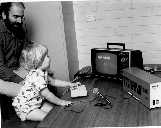
Paul Erdös circa 1980 |
The official Erdös Number Project
computes Erdös Numbers only via a path through papers eligible for citation in
a professional journal.
The compilers of The Erdös Number Project Extended take a more generous perspective, and extend the concept of
the Erdös Number to become the Erdös Number embodying a wider and deeper range of collaboration.
These web pages constitute our FAQ on the Erdös Number, just who or what is eligible, the youngest, oldest, and most fabjous awardees. In fact, fiction, animal, mineral, vegetable, or in the spiritual realm. circa 1980. |
How is an Erdös Number computed ? The key idea is that there has to be a path of joint publications, linking the awardee with Paul Erdös. The Erdös Number is the smallest number of links connecting a (joint) paper of the awardee with Paul Erdös. A full formal definition can be given using Graph Theory, but the idea is simple enough, to be explained by a simple example.
Alexander Zeno Cohen acquired an Erdös Number of four via the following path:
- Erdos, Paul; Wintner, Aurel. Additive arithmetical functions and statistical independence. Amer. J. Math. 61, (1939). 713--721.
- Sternberg, Shlomo; Wintner, Aurel On a class of analogies between differential equations and implicit equations. J. Analyse Math. 5 (1956/57), 34--46.
- Guillemin, Victor W.; Quillen, Daniel; Sternberg, Shlomo. The integrability of characteristics. Comm. Pure Appl. Math. 23 no. 1 (1970), 39--77.
- "American Academy Elects Quillen, Wunsch and Brown", TechTalk Vol 23 No 35 p1 May
16, 1979 -- including the pix to which Alexander contributed.
This publication would not be acceptable for the Official Erdös Number
What it Means: Close Distances from the Greats
For a mathematician, the Erdös Number essentially measires how mainstream one is.
It certainly is the case that Paul Erdös pulled above his weight with his voluminous list of publications.
But it is NOT the case that twentieth Century maths was primarily inspired by Paul Erdös.
Rather it is the case that the social community of Mathematics researchers are linked by joint papers,
and there are just a few links separating any two researchers active in the Twentith Century.
The compiler of this page trained as a mathematical physicist so has some links
to the mathematics community, leading to my unremarkable Erdös
number of 5. I was never a key mathematician. In fact very
many researchers of my vintage in a mathematically related discipline have an Erdös Number between 5 and 8.
But as I have just said, my primary early research was in mathematical physics:
and thus I do have short link numbers to several famous physicists. My shortest
Physicist Numbers are:
- Higgs Number of 2 - through a joint paper with Jack Smith, who was the very first student and collaborator with Peter Higgs. the 2013 Nobel Prize winner. In papers published around 1967 Higgs predicted what is termed the Higgs boson. See My Man in Stockholm.
- Schrodinger number of 3: Schrodinger with Heisenberg (my number is 4) developed the basics of Quantum Mechanics.
- Born Number of 3: Max Born was early worker in Quantum Mechanics who (especially) developed the probabilistic interpretation.
- Number of 4 various famous physicists, including Einstein, Pauli, Heisenberg, Oppenheimer, Weisskopf and Gerlach.

| To the left, Alexander Zeno Cohen, aged twenty months, with his father, using the 2-key (+ -) keypad for use with the PLUSMINUS program, a Tiny Tots Calculator, running on the Poly-88, a 1976 microcomputer. |
Alexander Zeno Cohen was only two years and four months old yet within the MIT community when a joint publication appeared which via the chain of publications ennumerated above acquired him an an Erdös Number of 4. (He was NOT three-years old as per the caption below.) Alexander's precocity might be attributed to his exposure, from the age of twelve months, to the educational programs of the OZNAKI Project, which was the first educational robotics project that was microcomputer based. With this background in OZNAKI, Alexander Zeno Cohen, in 1979 researched fluid mechanics in the MIT pool, along with the 1978 Field Medallist, Daniel Quillen, a professor of mathematics at MIT. The ensuing joint publication in the MIT house newspaper, TechTalk, (reproduced below), automatically gave Alexander an Erdös’s Number of 4, just one more than Quillen's Erdös’s Number of 3.
Here is a copy of the joint publication:


| Those who gain their knowledge of mathematics from that most reliable medium, the film, will learn from Good Will Hunting that publication in MIT TechTalk is the absolute pinnacle of mathematical achievement, if a little lower in stature than the actual award of a Fields Medal. Thus Alexander had it made within mathematics by the very publication of his exploits on the front page of TechTalk -- but it was nice that MIT's latest Field Medallist could assist him in gaining a low Erdös Number . |
More on Extended Erdos Numbers including some outrageous assignments.